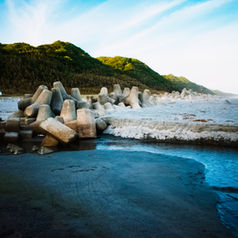From Beijing railway station, I head 80 minutes south of China’s bustling capital, to a tranquil area in the sleepy province of Hebei.
The bullet-train network in Northern China is already vast, and growing rapidly by the day, but as I vacate the train onto the platform I find myself alone in an eerily clean and quiet station. I follow the multi-lingual signs for the exit. There are a few people hovering around the departure lounge, but nothing like the swarms of commuters I saw in Beijing. I walk outside, and turn to photograph the large red Mandarin symbols that mark the entrance. This is Baiyangdian.

I first read about this peculiar place in an article by ‘The Economist’ back in 2008. The article focused on China’s water-diversion schemes, and the drought risks that face the region. Ten years on, and the country is still battling with its water-shortage crisis, but ambitious plans are now underway to redress the balance and cultivate ‘natural’ water supplies. One of the most notable mega-projects underway, ‘The South–North Water Transfer Project’, aims to channel 44.8 billion cubic meters of fresh water a year, from the Yangtze River in to the rapidly developing North. The government has also funded a colassal-scale weather modification program called ‘Sky River’, which is a cloud-seeding initiative that aims to artificially induce rainfall, by pumping silver iodide particles into the atmosphere. Tens of thousands of fuel-burning chambers are being installed across the Tibetan Mountains to release these particles and promote rainfall. And if the project proves to be a success, the agricultural industry in the Tibetan Plateau will flourish, and cloud seeding chambers will undoubtedly be rolled out across the arid Northern Plain. But of course, these controversial projects will have a butterfly-effect on the natural ecologies that are being unconsciously reshaped as a result. And as industrial development takes priority over the stability of complex ecosystems - for every square mile of cultivated land that receives more annual rainfall, there is a square mile elsewhere that will suffer a loss of rainfall as a result.
However, the Communist Party of China have recently unveiled plans for the future industrial development of the country, which appear (at least in concept), to be much more focused on wildlife cultivation and environmental stability. The “2030 Agenda for Sustainable Development”, established by the United Nations, will see China develop three key sustainable ‘zones’ that will act as city-scale showrooms. Each ‘zone’ (or city) will focus on the integration of innovative and sustainable technology. The President has approved Shenzhen, Guilin, and Taiyuan - as the three national showrooms. And funding will be channelled into China’s booming technology companies to develop new infrastructural blueprints. Each ‘zone’ will centre around a different environmental issue. In Shenzhen, technology companies will focus on sewage treatment, ecological restoration, and artificial intelligence to solve issues from resource management to pollution. In Guilin, the issue of desertification will be explored and companies will be promoted to develop modular systems that can be scaled and replicated by other regions that are facing the threat of encroaching deserts. And in Taiyuan, alternative solutions to air and water pollution will be explored. But as you may have noticed, Baiyangdian is not part of this list of showrooms. So why am I here?

Back in 2010, the Chinese government published plans to unveil its first ever ‘eco-city’, at the launch of the Shanghai World Expo. ARUP, an Internationally-renowned design and engineering company, were assigned with developing on the elusive wetlands of Dongtan, on Chongming Island (Shanghai). The area was, and still is, an important migration route for waterfowl in the Asia-Pacific region. So it was imperative that ARUP should develop the city with minimal disruption to the local ecosystem. The new city was marketed as a window into China’s green future. A showroom of sustainable urbanism. The continued migration of waterfowl would provide an objective barometer of success.
The city was expected to house 25,000 citizens by the launch of the Expo - but no houses were ever built. Instead, the office that had been allocated to the project closed down, and all promotion of the project was deleted from the Expo’s website. Now, with no-one managing the construction of the project, it is assumed that ARUP’s masterplan had been discarded, and the entire project was a green-marketing ruse.
Almost ten years on, and governmental greenwashing and pseudo-environmentalism has become all too common. The ghost of Dongtan looms over President Xi Jinping’s new sustainable ‘zones’ - which is precisely why Baiyangdian will provide a more accurate barometer of China’s true greening efforts over the next decade. Baiyangdian, like Dongtan, has recently been publically marked as a key site for ‘sustainable’ development. Taking inspiration from the successful Shanghai-Suzhou-Hangzhou commuter triangle, Xi Jinping is now looking to replicate a clustered network of cities around the country’s capital. The aim is to draw off non-essential commercial and industrial activity from Beijing, in order to ease conjestion and urban sprawl. Beijing will remain the administrative centre of the country; with highly-productive industrial mega-cities just a short commute away.
Unlike sprawling mega-cities like Tokyo and New York City that have developed densely populated boroughs over decades - China’s commuter-city-cluster model relies on a highly efficient railway network that warps perceptions of space and commutable time. The aim is to connect smaller cities within a two-hour region into one highly dispersed mega-city. The model has already been established with the highly-productive Yangzi River Delta, centred on Shanghai. And also the Pearl River Delta, centred on Shenzhen and Hong Kong. But the colossal Jingjinji Metropolitan Region, which is centred on Beijing, is yet to be fully realised. The region is largely composed of the the port city of Tianjin, capital city of Beijing, and the wider rural area of Hebei. And with Baiyangdian strategically located in the rural province of Hebei, next to the largest freshwater lake in North China - it is no surprise that the CPC plan to unify the region by developing a new mega-city here. The development is known as the ‘Xiongan New Area’, and is being marketed as a model for future sustainable urbanism. Like the ghost of Dongtan, the new city reguires careful planning to sustain the site’s local wetland ecosystem. But unlike Dongtan - construction has already begun.
Lake Baiyangdian will be the ‘green’ centerpiece of the ‘Xiong’an New Area’, as the skyscrapers rise up from the perimeter of the wetlands. The high-speed railway line already connects Beijing to this pre-city; so my experience of the place is uniquely fleeting - and I feel like I am witnessing the first portrait of a landscape-sized tryptic.

LIFE ON THE LAKE
After taking a short, but bumpy, journey from Baiyangdian station to the freshwater lake - I befriend a local family who take me to a popular boat docking area. A few local villagers are congregated around a wooden hut near a cluster of boats, so I pull out my mobile translation app and ask an elderly gentleman if he can show me around the lake. The villagers are animated by the fact that I want to see their stilted homes, and they offer lotus seeds and politely ask for photographs. I buy some seeds for the journey, and the elderly gentleman requests 15 yuan (€1.86) before we set off together in his small wooden fishing boat. We weave through the reeds into a wonderfully complex mosaic of over one hundred shallow freshwater lakes, thirty-nine villages, and vast fields of lotus flowers. I can feel the slow pace of life here as we drift along the water. He points out a cluster of houses and we moor up outside for a rest.
Unsurprisingly, the man knows everyone that we come into contact with. He takes me to a hut where three boys are firing rounds at targets in a shooting range, and they ask if I like shooting. I confess that I am a complete novice, and make an excuse to move on. We return to the boat and I ask if the shooting spooks the local geese and cormorants. His response is brief but honest. Shì, shì...yes.

As we drift along the lotus fields, he explains (via my translation app) that he has noticed a change in the waters in recent years. He laments about the number of motorboats that have appeared as a result of a rise in eco-tourism; claiming that the boats startle the fish and pollute the water. We pass a notice-board that appears to be advertising dog-fighting, and I begin to wonder how resilient this rural community of villagers will be in the face of rapid urbanisation. As modern infrastructure develops and the number of urban residents grows ecotourism may well prove to be far more lucrative than fishing and reed collecting as a vocation. In her academic paper, ‘Variations in ecosystem service values in response to changes in environmental flows: A case study of Baiyangdian Lake, China (2011)’, Wei Yang notes that “the number of fish species in Baiyangdian Lake decreased to 18 in 2000, from 54 species in 1958...as a result of the homogenization of species that has resulted from industrialization of the fishery”.

I cannot help but wonder whether the fate of the villagers will follow that of the fish. Perhaps they will be homogenized into the urban landscape. Or manufactured and marketed into a green caricature of ‘sustainability’. Either way, their livelihoods will undoubtedly change along with the landscape. But the realities of change and the loss of unsustainable culture need not always be cast in a negative light. The prospect of developing this mega-city from the ground up provides a rare opportunity for architects and urban planners to experiment with the natural-cultural order of the urban terrain. And with President Xi playing a pivotal role in launching the development, and overseeing its economical impacts - the growth of Xiong’an could follow a similar trajectory to the rapid urbanisation of Shenzhen and Pudong, which were largely seen as former leader Deng Xiaoping’s greatest achievements in urban reformation. Baiyangdian may lose its agricultural heart, but it stands to be reincarnated as Xi’s urban legacy..





Written by Steven Hutt
































